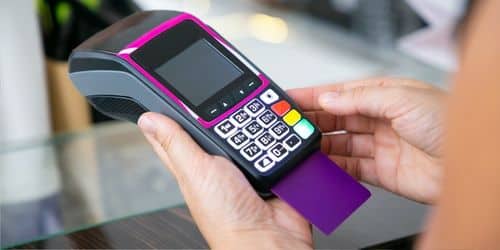Running a retail business involves a lot of technology. However, a point-of-sale (POS) terminal is the most crucial. It serves as the focal point for all of your company’s transactions and it does more than just handle payments and purchases; it also serves as a repository for vital information that can affect crucial business choices. That merely scratches the surface of what a POS terminal is capable of.
This article looks at what the POS terminal is, its types, prices, and a guide to how it is beneficial to your business.
What is a POS Terminal?
A POS terminal is a hybrid of hardware and software that handles all of your store’s transactions at the most fundamental level. Your store can sell goods, accept a variety of payment options, gather important business data, and streamline operations with a POS terminal.
The term “POS,” which also serves as a shorthand for this particular software and hardware combination, is referred to as “point of sale.” A POS system, or simply a POS, is another name for a POS terminal.
POS terminals are made up of several essential parts, such as:
- A smart device that runs point-of-sale software, such as a tablet or smartphone.
- A barcode reader that is compatible with the terminal.
- A payment terminal, also referred to as a card reader, that accepts all forms of payment, including credit cards, gift cards, and mobile payment methods.
All of the tasks listed in the following section, along with many others, are carried out by POS software, which makes it possible for these tools to cooperate.
What does a POS terminal do?
A traditional point-of-sale (POS) terminal reads the magnetic strip of a credit card or debit card when it is used to make a purchase to determine whether there are enough funds to transfer to the merchant and then actually makes the transfer. Thereafter, a receipt is printed or sent to the buyer via email or text after the sale transaction has been recorded. Depending on how they prefer to manage their cash flows, retailers can either purchase or lease a POS terminal. Note that while leasing equalizes monthly payments compared to buying a system outright, overall lease payments may exceed a one-time purchase throughout the system’s useful life.
A tablet or other mobile device can be used to load software-based point of sale (POS) systems, which are the current trend instead of using traditional proprietary hardware. POS terminal manufacturers are releasing their variations of portable and mobile POS devices to stay ahead of the curve.
These gadgets are common in crowded restaurants and retail establishments whose owners are aware that most patrons dislike having to wait while purchasing a meal or a product. For buyers of POS systems, price, functionality, and user-friendliness are crucial considerations. The security of the systems is crucial in a world that is becoming increasingly interconnected. Customers’ data has been compromised in some high-profile cases using POS terminals with outdated operating systems.
What are the 4 types of POS?
Small businesses use four different types of POS systems today:
1. Legacy POS system
A legacy POS system is also referred to as a traditional POS or an on-premises POS. The fact that a legacy system saves data locally sets it apart most significantly from other POS systems. It allows you to access your transactions and other information from the one device (or other devices on your closed network) that has saved them.
Notes that the hardware that powers this system is typically proprietary and is only available from the POS provider. Additionally, you will require assistance with system installation and maintenance when necessary.
Key features:
- Look up products in the system or scan product barcodes.
- Allows you to contact customers
- Total the purchases, taking into account taxes and special offers.
- Make payments.
- Report on important aspects of the business.
- It’s not dependent on an internet connection
- It provides robust data security.
2. Tablet-based POS system
A tablet-based POS system is referred to as a “modern POS system,”. A tablet-based system, which gets its name from the hardware it runs on, is also known as a touchscreen or iPad POS system.
Tablet-based retail POS systems run on a cloud-based network, making it convenient to make changes from anywhere, allowing for easy training and onboarding.
Furthermore, a tablet-based system typically has self-installation and self-upkeep features, allowing you to get started whenever you want.
Key features:
- Easy to get familiar with its tablet hardware
- Processing transactions can be done in several ways, such as by scanning a barcode and looking up products.
- It totals the purchases, taking into account taxes and special offers. processing payments for all possible payment types
- It gathers information about your clients and includes shopper notes with every transaction.
- It has various options for fulfillment, including shipping to customers and clicks and collect
- It provides detailed reporting on your sales, employees, clients, and inventory.
- It allows for the integration of social media for seamless marketing
3. Mobile POS system
The modern, portable POS system is called a mobile POS system and it runs on portable hardware, such as a tablet or smartphone. An excellent way to serve customers while they shop is with a mobile POS system. A handheld POS allows sales representatives to look up products and customer profiles to check inventory and provide tailored recommendations.
Mobile POS systems are great for line busting, pop-up selling, and self-setup and onboarding.
Key features
- It is a sleek, portable equipment
- Each worker can act as a check-out counter.
- In many cases, it has a built-in card reader
- It totals the purchases, taking into account taxes and special offers.
- It processes payments for all types of payments
- Easy to use, well-known hardware
- Possibly include a built-in barcode scanner, which simplifies the process of counting inventory.
- Several options are available for completing purchases, including shipping to home or click-and-collect.
- Its integrations with existing tools provide reporting and analytics to inform business decisions.
4. Cloud-based POS system
A cloud-based POS system is one where information is kept in the cloud as opposed to on a local device or network. This entails that you can access and modify business data from any location.
Cloud-based POS systems are the norm today as their data can be accessed from anywhere, but this opens the system up to more security lapses than a traditional POS system would. Additionally, the system may be unavailable if the internet is down because it depends on an internet connection to post data.
Key features:
- Since business data is stored in the cloud, it is accessible from anywhere.
- It can change your company’s operations from anywhere.
- It is a sleek and easy-to-use hardware
- It can total the purchases, taking into account taxes and special offers, and process payments for all types of payments.
- It has features for inventory management and options for different shopping fulfillment methods.
- It integrates your existing tech stack’s tools for advanced reporting and analytics capabilities.
What is an example of a POS terminal?
- Examples of Legacy POS system
The top legacy point-of-sale systems for retail include Aloha, Oracle MICROS, and Squirrel Systems.
- Examples of Tablet-based POS systems
Lightspeed POS, Square POS, and Shopify POS are some of the top tablet-based small business point-of-sale programs.
- Examples of Mobile POS systems
Some of the top mobile POS systems for small businesses include Lightspeed POS, Clover, and Square.
- Examples of Cloud-based POS systems
The top cloud-based POS systems for retail include Lightspeed POS, Square, and Clover.
How much does a POS terminal machine cost?
Price of Legacy POS system
The typical cost of a legacy POS system includes hardware costs of between $10,000 and $15,000, installation services that cost between $1,000 and $5,000, and support services that cost between $100 and $250 per month.
Price of Tablet-based POS system
Tablet-based point-of-sale systems require hardware, software, and customer support, ranging from $69 to $199 per month.
Price of Mobile POS system
Mobile POS systems have similar software costs as tablet-based systems, but hardware costs vary depending on the device.
Price of Cloud-based POS system
Cloud-based POS systems cost about the same as other modern POS systems. That implies that the required hardware, point-of-sale software, and occasionally customer support must be purchased.
What is a POS terminal in banking?
POS in banking means making a purchase with your debit card at a point of sale (POS) system or cash register in a store. Also known as “POS” transactions, POS transactions appear on bank statements.
To reconcile your POS transaction, follow these 5 steps:
- Compare your statements to internal records.
- Determine which transactions you are unable to cross-reference.
- Check the incoming money on both documents.
- For possible errors, get in touch with your bank.
- Keep a well-balanced library
What are the 5 types of POS systems?
1. Traditional POS System
The traditional register-based system is a POS software frequently used in restaurants. Its POS features, however, can be quite complicated and may need a dedicated staff member to manage and operate them, making employee management a challenge as well.
Note that this is the least expensive option.
2. Touch Screen POS System
The touchscreen POS system is another type of POS system for businesses. It is a POS system that makes use of a contemporary POS terminal that is quicker and more precise.
Tablet POS systems are popular for quick-service businesses, digital menu boards, and online payment processing, allowing for a more streamlined ordering process and more accurate payments.
3. Dedicated Server POS System
Dedicated server POS systems are the most expensive and need the most upkeep, but this kind of POS system offers the most features and customization options.
This POS system offer scalability, customization, and IT support, making them ideal for businesses that want to offer a unique experience to their customers.
4. Cloud-Based POS System
Cloud-based POS systems have fewer features than dedicated systems but are less expensive and simpler to set up. Data stored by this kind of POS system is accessible from anywhere because it is stored in the cloud.
However, the fact that cloud-based POS systems need a strong internet connection to function properly is one drawback. The system won’t be able to work if the internet connection is down.
5. Mobile POS System
Mobile POS systems, which are the most portable and can be used anywhere, might not have all the features of a larger system. They are becoming more and more popular among restaurants of all sizes.
Advantages of using POS Terminal for your business
1. It allows for better Inventory Management
A POS (point of sale) system allows stores to manage their inventory in real time and keep track of the quantity of each item in stock.
2. It allows for simple Invoicing
You can keep track of and organize all of your invoices using point-of-sale software. In a business, managing different types of invoices requires the ability to recognize them quickly. Depending on the software, you can find invoices for purchases, sales, repairs, rentals, consignments, and other things.
The point of sale makes it easier to issue invoices, record purchase information, and sell faster than if done manually.
3. Faster and easier Payments
Customers can pay by cash, credit, or debit card, making payments faster and easier. The amount of time customers must wait to complete transactions is significantly reduced with a point-of-sale.
4. It provides better Customer Satisfaction
With a POS system, it’s easier to exceed consumers’ initial expectations by providing fast, accurate, and efficient service. By combining these three components, customers will surely be more satisfied and will likely return to your store.
Customers are more likely to remain loyal to your business when they are more satisfied. This can be a huge benefit for your company because it is frequently simpler to retain current clients than to win new ones. You can lower your risk of losing customers and revenue by cultivating a satisfied and devoted customer base.
5. Better Security
Data security is crucial for any business. Only authorized users of the company should have access to your data. Your data is better protected from unauthorized intrusion when using a POS system. In most systems, user authentication is doubled. As a result, fewer malicious users will access your system. Additionally, the administrator can quickly permit or deny users access.
It is advised that you use the cloud-based POS to back up and protect data from disasters.
CARD MACHINE: Meaning, Types, Application & Prices
FREE CARD READER: Best Credit Cards 2023
WHAT IS A POS: How It Works, Insurance & What You Should Know
AGILE SPRINT: Definition, Process, Review, Cycle & Planning






